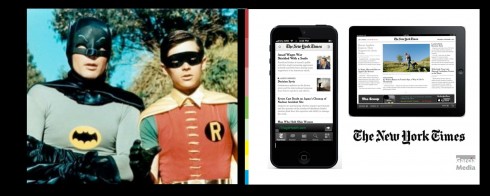This is the weekend edition of TheMarioBlog and will be updated as needed. The next blog post is Monday, October 7
TAKEAWAY: Those tablets are becoming more lean forward all the time; new data offers surprises about phones/tablets

In one of my most recent conversations with a designer colleague, I was telling her that we no longer can design assuming that our creation will be consumed in one specific setting. With mobile devices, it is possible that one person may be reading our story about the 10 best French champagnes while commuting to work in the subway, but someone else may be enjoying the experience at the dentist’s office, with a third perhaps grabbing a quick lunch bite sitting in the park.
These locations and situations are quite different for how we consume the information, except that if we have done our job right, we have engaged the user, allowing him/her to momentarily abandon the immediate surroundings and getting immersed in our story.
Now we get a new study about the time users reach for their phones and tablets. According to new statistics released by app analytics specialists Localytics, people are most active on their smart devices at 9 p.m., with a lull setting in between 3 a.m. and 4 a.m. However, there is constant use throughout the day.
It is reassuring to know that we are not connected to our mobile devices while we sleep, or in the middle of the night.
Phones, tablets: dynamic duo
But this most recent research about mobile device usage does present at least one surprise, especially because it brings attention to what we have already observed for months: more and more, the phone and the tablet seem to compete with each other for our attention. Perhaps it is not even a case of competition, but one of a forced union.
In the United States, the research shows that the tablet and phone are used often between the hours of 9 a.m. and 7 pm.
Here we see a shift from when the first iPads came out in 2010, a time in which the evening was the time most people would lean back with their new toy. In fact, the tablet seemed to be at its peak use between 7 p.m. and 11 p.m., a time when many are watching prime time television.
While the tablet is still more lean back than the smartphone, it is quickly getting to be also a lean forward device, and this research seems to support that.
The use of the two devices gets more heated during the prime time hours of the evening. Still, the phones have the advantage, maybe because they are smaller, or the fact that we have declared them our inseparable companions.
It would be interesting to see research about how each platform is used during these evening hours. In my own experience, the tablet is associated with relaxation, with longer reads, more videos and photo galleries, the phone is a point of reference for a quick scan. Or, is it?
Mobile devices and frequency of use
While we may hold on to the phone for most of our waking hours, we tend to use it to read news more likely on the morning commute. I wonder if there are statistics available for use of the phone to read news even earlier than that. We know that many turn to their phone before they even brush their teeth. Here is what the Localytics research shows:
News app readerships hit a peak at 7am but drop off precipitously at 9 a.m., when workers clock in for the day. For other categories, usage sees a steady improvement from 6 am right up until about 9 p.m.
As many of us devote time to product development, this and future research helps tremendously.
We already know that we design for what Rachel Hinman refers to as “everywhereness”. I believe that we also create content for “instantness”. With our audience carrying their platforms with them around the clock, it is imperative that we remember those two concepts of the every and anywhere and the here and now.
Of related interest
Hinman, Rachel. _“The Mobile Frontier: A Guide for Designing Mobile Experiences.” _Rosenfeld Media, 2012. iBooks.